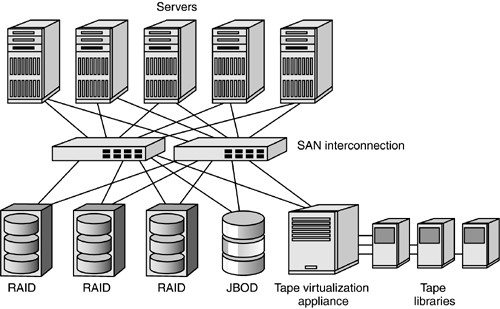11.8 Tape Virtualization
| Virtualization of tape subsystems relies on an in-band intervention between backup servers or appliances (such as third-party copy agents) and tape libraries. Without the assistance of virtualization intelligence, backing up multiple servers to tape requires multiple tape targets, each with its own tape drives and media control. As the population of servers increases, additional tape drives and media are required, as are additional administrators to oversee backup operations. A tape virtualization engine may sit in the SAN in the data path between servers and tape subsystems, as shown in Figure 11-10. As with disk storage virtualization, the physical configuration of tape subsystems is transparent to the servers or extended copy agents. Instead, the tape virtualization appliance presents the image of a high-capacity, multidrive tape subsystem that can accept backup streams from multiple servers concurrently. The tape virtualization appliance can contain high-performance cache memory to absorb the backup streams before spooling them to physical tape drives. Because the individual tape drives and associated media are not dedicated to separate backups, fewer physical tape drives are required and use of media can be maximized. Figure 11-10. Virtualizing tape backup for performance and reduced administration
Combined with disk storage virtualization, tape virtualization offers further efficiencies to shrink the physical footprint of the SAN and reduce administrative costs. Despite the somewhat surreal sensation generated by the notion of virtual disk backing up to virtual tape, ultimately the data on both disk and tape is quite real. The challenge for vendors is to implement these virtualization schemes with sufficient integrity checks to ensure accurate data storage, archival, and retrieval. |
EAN: 2147483647
Pages: 171
